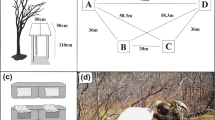Summary
-
1.
Given the right circumstances, toads will detour round a paling fence to reach their prey on the other side. In programming this manoeuvre, toads take into account both the position of the fence and the distance of the prey (Fig. 1). Should there be a gap in the fence, which offers a more direct approach, toads will aim for that instead (Fig. 2).
-
2.
The argument developed in this paper is that, when a toad decides upon a particular approach, it is guided by the sum of its reactions to several individual features of the situation, such as the length of the fence, the presence or absence of gaps, the gaps' width (Fig. 7) and their proximity to the prey (Fig. 11) and to the toad's long axis (Fig. 10). When there are several possible approaches, toads will select the gap (or edge) which has the most ‘attractive’ combination of features.
-
3.
The relative attraction of gaps can be manipulated and toads will then shift their preference. Normally, toads head for the gap lying closest to the prey and to their long axis (Figs. 9a and 12b). However, if the relative salience of a more peripheral gap is increased the bias towards the closer gap is reduced (Fig. 9b).
-
4.
Toads tend to choose the closest gap even when it is inappropriate to do so. They seem unable to use the spatial information potentially available to them to pick out the shortest, unobstructed path to their prey. The major support for this view comes from the way they treat double fences composed of two rows of palings. With both fences unbroken, toads usually detour around them (Fig. 2d). However, when a gap is inserted in the front fence, they will often aim for that, regardless that the rear fence blocks their subsequent approach (Figs. 2c and 4). If palings are added to join the ends of the two fences, toads continue to aim for the gap, though once they have entered the space between the two fences, all they can do is to retrace their steps.
-
5.
It is not that toads are blind to the rear fence. They can detect gaps in it (Fig. 8a) and their behaviour is influenced by the distance between the rear fence and their prey (Fig. 6). Nonetheless, a gap restricted to the front fence is still treated as a gap, but as less attractive than one extending through both fences (Fig. 8b). And, if such a gap is close to the toad's midline and the prey, then toads are drawn to it, rather than to the ends of the fence.
Similar content being viewed by others
References
Collett T (1977) Stereopsis in toads. Nature 267:349–351
Didday RL (1976) A model of visuomotor mechanisms in the frog optic tectum. Math Biosci 30:169–180
Ewert J-P, Gebauer L (1973) Grössenkonstanzphänomene im Beutefangverhalten der Erdkröte (Bufobufo L.). J Comp Physiol 85:303–315
Ingle DJ (1971) Prey-catching behaviour of anurans toward moving and stationary objects. Vision Res (Suppl) 3:447–456
Ingle D (1976a) Spatial vision in anurans. In: Fite KV (ed) The amphibian visual system — a multidisciplinary approach. Academic Press, New York
Ingle D (1976b) Behavioral correlates of central visual functions in anurans. In: Llinás R, Precht W (eds) Frog neurobiology. Springer, Berlin Heidelberg New York, pp 435–451
Ingle D, Cook J (1977) The effect of viewing distance upon size preference of frogs for prey. Vision Res 17:1009–1013
Ingle D, Sprague JM (1975) Sensorimotor function of the midbrain tectum. Neurosci Res Program Bull 13:169–288
Kondrashev SL (1979) Influence of the visual stimulus size on the breeding behaviour of anuran males. Acad Nauk Zool J 55:1576–1579
Lara R, Arbib MA (1981) A neural model of interaction between pretectum and tectum in prey selection. COINS technical report, pp 81–84
Lock A, Collett T (1979) A toad's devious approach to its prey: a study of some complex uses of depth vision. J Comp Physiol 131:179–189
Lock A, Collett T (1980) The three-dimensional world of a toad. Proc R Soc Lond [Biol] 206:481–487
Thomson JA (1980) How do we use visual information to control locomotion? Trends Neurosci 3:247–250
Author information
Authors and Affiliations
Rights and permissions
About this article
Cite this article
Collett, T.S. Do toads plan routes? A study of the detour behaviour ofBufo viridis . J. Comp. Physiol. 146, 261–271 (1982). https://doi.org/10.1007/BF00610246
Accepted:
Issue Date:
DOI: https://doi.org/10.1007/BF00610246




